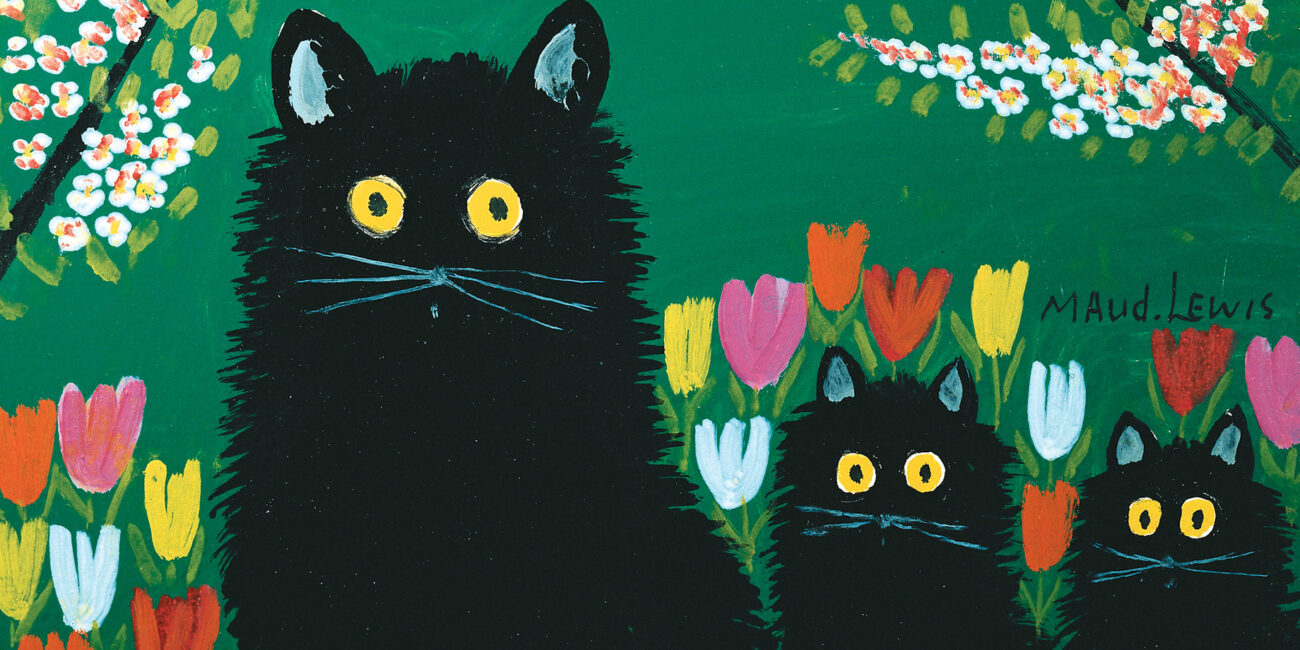This blog was written and submitted by the Art Gallery of Nova Scotia, home of the largest public collection of Maud Lewis’ art and her original house.
If you are from Nova Scotia, there is a high probability you know of celebrated folk-artist Maud Lewis, but if you aren’t from the area there’s a good chance you don’t know who she was!
Here are 13 facts you may not have known about Maud Lewis:
-
Maud Dowley was born on March 7, 1903 in South Ohio, Nova Scotia and lived her entire life within a one hour drive of her birthplace.
- Although Maud was born with a number of birth defects, she was a happy child, well-loved in particular, by her mother Agnes who instilled in Maud her love of music and art. Maud’s first known artistic endeavors were hand-painted Christmas cards which she sold door-to-door with her mother for five cents each. Maud’s happy childhood would be reflected in her artwork for the rest of her life.
- Maud’s father, John Nelson, was a harness maker and blacksmith and the family was relatively prosperous, proof of which included a piano and a phonograph, luxuries during that time.
- After her father died in 1935 and her mother in 1937, Maud lived in the family home with her brother Charles and his first wife. But, when that marriage fell apart and the house was sold, Maud was sent to live with her Aunt Ida Germaine in Digby. Maud received none of the proceeds from the sale of the estate, and she brought with her very few personal possessions.
- Although she was welcomed in her Aunt’s comfortable home, she answered an ad for a housekeeper posted by Everett Lewis, a poor fish peddler. After what could be considered a very non-traditional romance, Everett and Maud married in 1938, not long after they met. He was 44 and she was 36 or 37.
- The Lewises moved into Everett’s house, a tiny shack-like structure so close to the road that a truck driver could roll down his window and toss a cigarette through the door. The house measured 4.1 x 3.8 meters with only three windows and a loft – a distinctly impractical set-up for Everett who was a tall man.
- Everett and Maud lived in poverty, without indoor plumbing and with only oil lamps for light. The wood stove was their only source of heat for both cooking and living. Most of their money came from the sale of Maud’s artwork.
- The house became one of Maud’s earliest and most striking canvases. She painted not just on the outside and the inside of the house, including on the stairs and the windows, but painted on many of the household objects like the wood stove, the bread box, a dustpan and serving trays.
- The house was so bright and colorful many people stopped on the road to admire the painted daffodils on the windows, bluebirds on the storm doors and the butterflies and swans on the inside door. Later, tourists and travelers from all walks of life were attracted by her hand-painted sign offering her wares for sale.
- Maud died in 1970 from pneumonia at the age of 67. She was buried in a child’s coffin. Everett did not erect a gravestone but put Maud’s name at the bottom of the Lewis family stone. It is not clear why he used her maiden name Maud Dowley.
- After Maud’s death, Everett continued to live in his tiny house with no obvious source of income, although many in the community believed he had money hidden on his property. In 1979 he died a violent death when he refused to disclose the location of the money to a robber.
- In 1984 the Province of Nova Scotia purchased the house from the Painted House Society and had the house moved to a temporary location to preserve it. Ownership was transferred to the Art Gallery of Nova Scotia and the house was moved to a temporary location at Sunnyside Mall in Bedford, Nova Scotia where it was meticulously restored. The house was then transferred to its permanent location in the Scotiabank Maud Lewis Gallery at the Art Gallery of Nova Scotia in Halifax, Nova Scotia.
- After Everett died, his heir Barry Jennings sold the Lewis house to the Maude (sic) Lewis Painted House Society for $11,000 in 1980.


